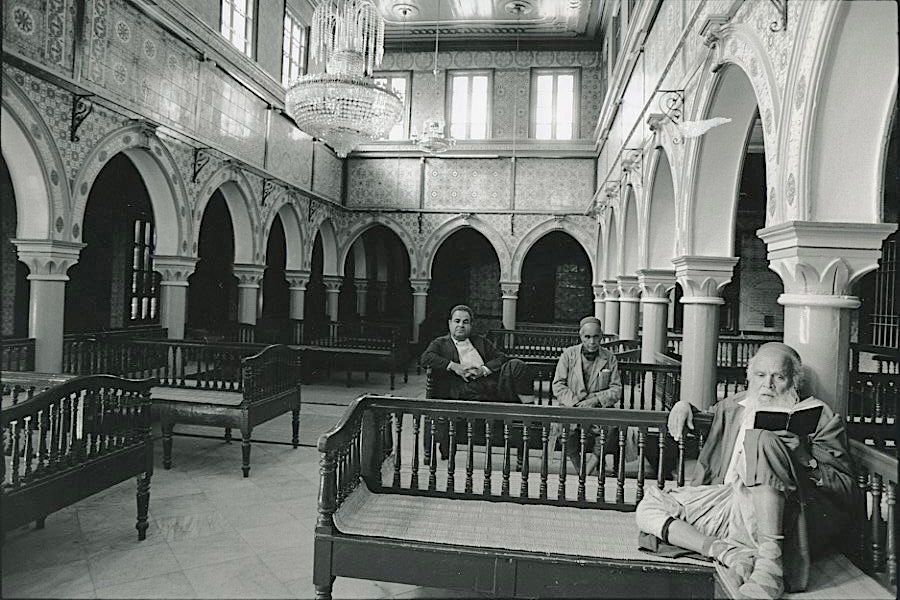The content and images in this curriculum and presentation are copyrighted and trademarked. Photographs’ subject matter is divided into categories. All photographs are by Zion Ozeri. You may only use the presentation or parts of it while implementing the DiverCity Lens in your school. For any other use, including reproduction, you must get special permission from Zion Ozeri. The use of the following content, which may be objectionable, is at your own risk, and Zion Ozeri holds no responsibility to evaluate the accuracy, completeness, and usefulness of any content provided, prior to your use. You may contact Zion Ozeri for any questions: zion@zionozeri.com
The Departure and Expulsion of the Jews from Muslim Countries
Lesson Plan by Zion Ozeri, Josh Feinberg, and Dara Unterberg

”Waiting for Seven Jews”, El Ghriba Synagogue, Djerba, Tunisia, 1995
All images © Zion Ozeri. All Rights Reserved.
Look closely at this photograph and discuss:
- Describe the scene.
- Why do you think the photographer titled this portrait, “Waiting for Seven Jews”?
- Based on the photograph, how can the story of the Jewish communities in Moslem countries be told?
- Is this a story of displacement and expulsion or one of redemption? Explain.
Note to educators:
In the photograph, three men are seen sitting inside a synagogue. The image is titled “Waiting for Seven Jews,” a reference to the Jewish requirement of a minyan - a quorum of ten Jewish adults necessary for certain communal prayers and religious obligations. The presence of a minyan is central to many aspects of Jewish worship and communal life. When ten or more Jews gather for prayer, the group is also considered a kehilah, or community. The men in the photograph are among the last remaining members of the once-thriving Jewish community in Djerba.
Read the following texts:
The El-Ghriba Synagogue is located on the Tunisian island of Djerba. While the current structure dates to 1929, there is a communal belief that a synagogue has stood on this site for over 2,000 years. According to tradition, the original building was constructed using a stone from the destroyed Temple in Jerusalem. The architectural details, patterns, shapes, and motifs, reflect a strong influence of Islamic art and culture. Despite several terrorist attacks in recent years, the synagogue continues to host an annual Jewish pilgrimage, drawing visitors from around the world.
The Tunisian Jewish community has existed for over 2,300 years. Major religious and spiritual leaders came from there, as well as leading international merchants. In 1881 Tunisia was conquered by the French, and the Jewish community grew, becoming active both politically and socially. Following Tunisia's independence from France in 1956, the vast majority of Tunisian Jews emigrated; most to France, and many to Israel. A once thriving community of over 100,000 in the mid-20th century has now diminished to fewer than 1,500, with most of the remaining population living on the island of Djerba
Albert Memmi (1920–2020) was a well known Jewish writer and philosopher born in Tunisia. The following excerpt is from his introduction to his book Jews and Arabs.
“Yes, indeed, we were Arab Jews- in our habits, our culture, our music, our menu…But must one remain an Arab Jew if, in return, one has to tremble for one’s life and the future of one’s children and always be denied a normal existence?
The supposedly ideal life of the Jews in Arab lands is nothing but a myth!…As far as the memories of my childhood go, in the stories of my father, my grandparents, my aunts and my uncle, living alongside the Arabs was not just uncomfortable, but it was filled with threats, which from time to time changed from the potential for violence to actuality. At the same time, one very significant fact should be remembered: during the colonial period [periods of European control of Muslim countries], the situation of the Jews was more secure, since it had a stronger legal basis.
… At no time – and I say this expressly: at no time – apart from two or three periods that involved unusual circumstances, and even then barely so – were the Jews who lived in Arab countries seen as anything other than persons of insignificant worth, open to dangers and subject to the occasional bouts of murder and killing, so that they should well remember their status."
Discuss:
- What does the El-Ghriba Synagogue reveal about the long-standing relationship between Jewish and Muslim cultures in Tunisia?
- How did big historical events - like French rule, independence, and the establishment of the State of Israel change life for Jewish people in Tunisia? Why did so many leave?
- Albert Memmi said he felt both Arab and Jewish, but also felt unsafe. Is it possible to belong to two cultures at the same time? What problems might someone face if they do?
- Why do you think the Jewish community on the island of Djerba has survived even after so many others left?
- Why do you thinkJewish people continue to make pilgrimages to the El-Ghriba Synagogue?
Recommended Reading:
El Ghriba Synagogue, Djerba, Tunisia | ANU Museum of the Jewish People | Open Databases
WJC The expulsion of Jews from Arab countries and Iran
Click here to learn more: A brief History of Jews in Arab Lands.
Follow-up activities:
Interview and photograph someone (a family member, neighbor, or acquaintance) who came from one of the Islamic countries.
Sample Questions:
- Can you tell me about the country you came from and what it was like growing up there? (Follow-up: What do you miss most about it?)
- Why did you or your family decide to leave your home country? (Follow-up: Was it a hard decision?)
- What was it like when you first arrived in your new country? What was difficult, and what helped you adjust?
- What traditions, foods, or holidays from your original culture do you still celebrate or remember today?
- Do you think your identity has changed since moving to a new country? If so, how?
- If you could share one memory or message about your experience with others, what would it be?
Photography Prompt:
After the interview, ask the person if you can take a photo of them with something meaningful to them from their past, such as a family photo, a cultural object, a religious item, or a favorite recipe.
